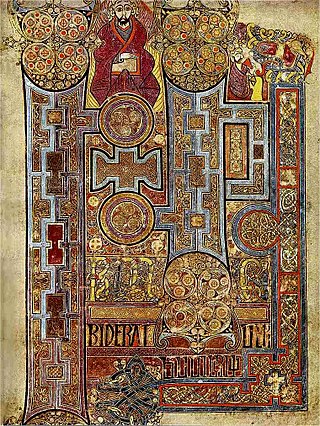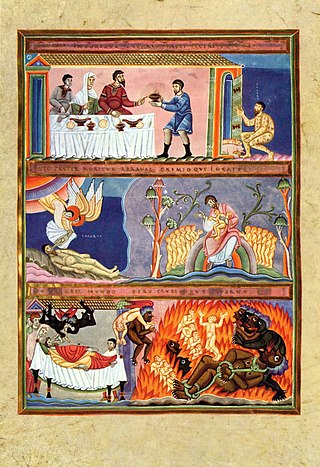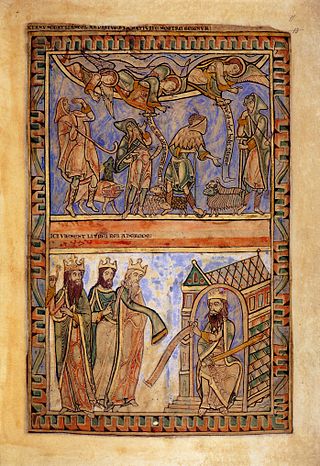
The medieval art of the Western world covers a vast scope of time and place, over 1000 years of art in Europe, and at certain periods in Western Asia and Northern Africa. It includes major art movements and periods, national and regional art, genres, revivals, the artists' crafts, and the artists themselves.

Anglo-Saxon art covers art produced within the Anglo-Saxon period of English history, beginning with the Migration period style that the Anglo-Saxons brought with them from the continent in the 5th century, and ending in 1066 with the Norman Conquest of England, whose sophisticated art was influential in much of northern Europe. The two periods of outstanding achievement were the 7th and 8th centuries, with the metalwork and jewellery from Sutton Hoo and a series of magnificent illuminated manuscripts, and the final period after about 950, when there was a revival of English culture after the end of the Viking invasions. By the time of the Conquest the move to the Romanesque style is nearly complete. The important artistic centres, in so far as these can be established, were concentrated in the extremities of England, in Northumbria, especially in the early period, and Wessex and Kent near the south coast.

Carolingian art comes from the Frankish Empire in the period of roughly 120 years from about 780 to 900—during the reign of Charlemagne and his immediate heirs—popularly known as the Carolingian Renaissance. The art was produced by and for the court circle and a group of important monasteries under Imperial patronage; survivals from outside this charmed circle show a considerable drop in quality of workmanship and sophistication of design. The art was produced in several centres in what are now France, Germany, Austria, northern Italy and the Low Countries, and received considerable influence, via continental mission centres, from the Insular art of the British Isles, as well as a number of Byzantine artists who appear to have been resident in Carolingian centres.

Ottonian art is a style in pre-romanesque German art, covering also some works from the Low Countries, northern Italy and eastern France. It was named by the art historian Hubert Janitschek after the Ottonian dynasty which ruled Germany and northern Italy between 919 and 1024 under the kings Henry I, Otto I, Otto II, Otto III and Henry II. With Ottonian architecture, it is a key component of the Ottonian Renaissance. However, the style neither began nor ended to neatly coincide with the rule of the dynasty. It emerged some decades into their rule and persisted past the Ottonian emperors into the reigns of the early Salian dynasty, which lacks an artistic "style label" of its own. In the traditional scheme of art history, Ottonian art follows Carolingian art and precedes Romanesque art, though the transitions at both ends of the period are gradual rather than sudden. Like the former and unlike the latter, it was very largely a style restricted to a few of the small cities of the period, and important monasteries, as well as the court circles of the emperor and his leading vassals.

Insular art, also known as Hiberno-Saxon art, was produced in the post-Roman era of Great Britain and Ireland. The term derives from insula, the Latin term for "island"; in this period Britain and Ireland shared a largely common style different from that of the rest of Europe. Art historians usually group Insular art as part of the Migration Period art movement as well as Early Medieval Western art, and it is the combination of these two traditions that gives the style its special character.

Egbert was the Archbishop of Trier from 977 until his death.

The Gospels of Otto III is considered a superb example of Ottonian art because of the scope, planning, and execution of the work. The book has 276 parchment pages and has twelve canon tables, a double page portrait of Otto III, portraits of the four evangelists, and 29 full page miniatures illustrating scenes from the New Testament. The cover is the original, with a tenth-century carved Byzantine ivory inlay representing the Dormition of the Virgin. Produced at the monastery at Reichenau Abbey in about 1000 CE., the manuscript is an example of the highest quality work that was produced over 150 years at the monastery.

The Codex Aureus of Echternach is an illuminated Gospel Book, created in the approximate period 1030–1050, with a re-used front cover from around the 980s. It is now in the Germanisches Nationalmuseum in Nuremberg.

The Stavelot Bible is a Romanesque illuminated manuscript Bible in two volumes datable to 1093-1097. It was produced for, but not necessarily in, the Benedictine monastery of Stavelot, in the Principality of Stavelot-Malmedy of modern Belgium, and required four years to complete. It was probably the main liturgical Bible of the monastery, kept on the altar of the abbey church or in the sacristy, rather than in the library. It is one of the most important Mosan manuscripts of the last quarter of the 11th century, and shares some of its scribes and artists with the earlier Lobbes Bible and a manuscript of Josephus, in all of which a monk called Goderannus was at least a scribe, and possibly the main artist. For many years it was in the Royal Library at Bamberg, until it was acquired by the British Library in London, where it is catalogued as Add MS 28106-28107. The pages measure 581 x 390 mm, and there are 228 and 240 leaves in the two volumes.

The Winchester Psalter is an English 12th-century illuminated manuscript psalter, also sometimes known as the Psalter of Henry of Blois, and formerly known as the St Swithun's Psalter. It was probably made for use in Winchester, most scholars agreeing that the most likely patron was the Henry of Blois, brother of Stephen, King of England, and Bishop of Winchester from 1129 until his death in 1171. Until recent decades it was "a little-studied masterpiece of English Romanesque painting", but it has been the subject of several recent studies.

The Eadwine Psalter or Eadwin Psalter is a heavily illuminated 12th-century psalter named after the scribe Eadwine, a monk of Christ Church, Canterbury, who was perhaps the "project manager" for the large and exceptional book. The manuscript belongs to Trinity College, Cambridge and is kept in the Wren Library. It contains the Book of Psalms in three languages: three versions in Latin, with Old English and Anglo-Norman translations, and has been called the most ambitious manuscript produced in England in the twelfth century. As far as the images are concerned, most of the book is an adapted copy, using a more contemporary style, of the Carolingian Utrecht Psalter, which was at Canterbury for a period in the Middle Ages. There is also a very famous full-page miniature showing Eadwine at work, which is highly unusual and possibly a self-portrait.

The Old English Hexateuch is the collaborative project of the late Anglo-Saxon period that translated the six books of the Hexateuch into Old English, presumably under the editorship of Ælfric of Eynsham. It is the first English vernacular translation of the first six books of the Old Testament, i.e. the five books of the Torah and Joshua. It was probably made for use by lay people.

The Hand of God, or Manus Dei in Latin, also known as Dextera domini/dei, is a motif in Jewish and Christian art, especially of the Late Antique and Early Medieval periods, when depiction of Yahweh or God the Father as a full human figure was considered unacceptable. The hand, sometimes including a portion of an arm, or ending about the wrist, is used to indicate the intervention in or approval of affairs on Earth by God, and sometimes as a subject in itself. It is an artistic metaphor that is generally not intended to indicate that a hand was physically present or seen at any subject depicted. The Hand is seen appearing from above in a fairly restricted number of narrative contexts, often in a blessing gesture, but sometimes performing an action. In later Christian works it tends to be replaced by a fully realized figure of God the Father, whose depiction had become acceptable in Western Christianity, although not in Eastern Orthodox or Jewish art. Though the hand of God has traditionally been understood as a symbol for God's intervention or approval of human affairs, it is also possible that the hand of God reflects the anthropomorphic conceptions of the deity that may have persisted in late antiquity.
The Hitda Codex is an eleventh-century codex containing an evangeliary, a selection of passages from the Gospels, commissioned by Hitda, abbess of Meschede in about 1020. It is held at University and State Library Darmstadt. Hitda is depicted in the book's dedication miniature presenting the codex to the convent's patron, Saint Walburga. St. Walburga stands on a pedestal in the center of the composition, and has a golden halo surrounding her head. Behind the two women is the monastery that Hitda oversees, which fills the entire background.

The Leofric Missal is an illuminated manuscript, not strictly a conventional missal, from the 10th and 11th century, now in the Bodleian Library at Oxford University where it is catalogued as MS Bodl. 579.

The Sacramentary of Henry II, also called the Regensburg Sacramentary, is a manuscript of liturgical texts, which was created in Regensburg at the order of Emperor Henry II. It is among the most significant works of Ottonian illumination. The manuscript was gifted to Bamberg Cathedral by Henry II, was part of the Cathedral treasury until 1803 when it became part of the Bavarian State Library as a result of Secularisation. It remains there today, stored under the inventory number clm 4456. It is modelled on the Codex Aureus of St. Emmeram donated by Charles the Bald in 870.

A presentation miniature or dedication miniature is a miniature painting often found in illuminated manuscripts, in which the patron or donor is presented with a book, normally to be interpreted as the book containing the miniature itself. The miniature is thus symbolic, and presumably represents an event in the future. Usually it is found at the start of the volume, as a frontispiece before the main text, but may also be placed at the end, as in the Vivian Bible, or at the start of a particular text in a collection.
The Sainte-Chapelle Gospels or the Sainte-Chapelle Gospel Book is an Ottonian illuminated manuscript now housed in the Bibliothèque nationale de France in Paris as Latin 8851. It is made up of 156 parchment folios, in a 38.5 cm by 28 cm format, making it one of the largest manuscripts of its era. It includes miniatures such as the canon tables, Christ in majesty and the Four Evangelists. It is the work of the Master of the Registrum Gregorii, the most famous illuminator of the Ottonian Renaissance.

The Codex Wittekindeus is a 128-folio illuminated Gospel Book, produced in Fulda Abbey in Germany around 970–980. Alongside the Gero Codex, the Codex Wittekindeus is considered one of the two "greatest works in the initial Ottonian revival of book-illumination".

The Petershausen Sacramentary is an Ottonian illuminated manuscript of around 960–980, produced in the scriptorium of Reichenau Abbey and containing the sacramentary and liturgical calendar. It is now held in the Heidelberg University library.

























